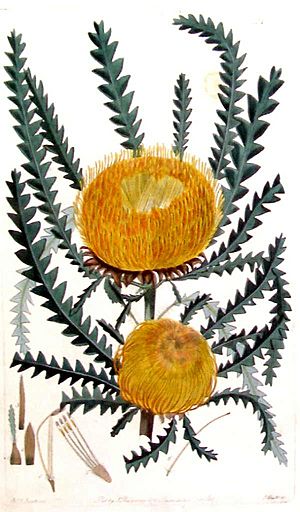Dryandra subg. Dryandra facts for kids

Dryandra subg. Dryandra was a special group of plants that scientists used to classify. Think of it like a specific team within a larger sports club. This group is now considered "obsolete," meaning it's no longer used. Why? Because all the plants that were once in the Dryandra group, including this subgroup, have been moved into the Banksia plant family.
This group had a few different names over time. It was first called Dryandra verae in 1830. Later, it was renamed Eudryandra in 1847. Finally, in 1996, it became Dryandra subg. Dryandra (subg. means subgenus, a rank below genus). But in 2007, two scientists, Austin Mast and Kevin Thiele, decided that Dryandra plants were so similar to Banksia plants that they should all be in the same group. So, Dryandra was officially merged into Banksia, and this old classification system was no longer needed.
Contents
Early Ideas: Brown's "True Dryandra"
In 1830, a scientist named Robert Brown published his ideas about how to organize Dryandra plants. He called his main group Dryandra verae, which means "True Dryandra." Brown noticed that some Dryandra plants had a single "seed separator" inside their seed pods (called follicles). He used this feature to create different sections or subgroups.
Brown's system looked something like this:
- Dryandra (now part of Banksia)
- Dryandra verae (this group had plants like D. formosa, D. nivea, and many others)
- D. sect. Diplophragma (just one species)
- D. sect. Aphragma (four species)
This was one of the first attempts to sort these plants, and it included many well-known species that are now part of the Banksia family.
Meissner's New Name: Eudryandra
Later, in 1847, another scientist, Stephan Endlicher, changed the name Dryandra verae to Eudryandra. This new name was then used by Carl Meissner in his plant arrangement in 1856. Meissner kept Brown's main sections but made things even more detailed. He divided D. sect. Eudryandra into eight smaller subgroups.
Meissner's detailed system for D. sect. Eudryandra included many species, grouped by their features. For example, he had:
- D. § Ilicinæ (like D. praemorsa, now Banksia undata)
- D. § Runcinatæ (like D. armata, now Banksia armata)
- D. § Serratæ (like D. formosa, now Banksia formosa)
- And five other sections, each with various species.
This shows how scientists kept refining their understanding of these plants, adding more layers to their classification.
Bentham's Simpler Approach
In 1870, George Bentham published his own way of organizing Dryandra plants in a big book called Flora Australiensis. He kept the name D. sect. Eudryandra, but he simplified Meissner's many small subgroups. Instead, Bentham created seven new "series" based on the flowers of the plants.
Bentham's system for D. sect. Eudryandra included:
- D. ser. Armatae (7 species, like D. quercifolia, now Banksia heliantha)
- D. ser. Floribundae (5 species, like D. floribunda, now Banksia sessilis)
- D. ser. Concinnae (4 species, like D. squarrosa, now Banksia squarrosa)
- D. ser. Formosae (5 species, like D. formosa, now Banksia formosa)
- D. ser. Niveæ (4 species, like D. nivea, now Banksia nivea)
- D. ser. Obvallatae (12 species, like D. sclerophylla, now Banksia sclerophylla)
- D. ser. Gymnocephalae (3 species, like D. speciosa, now Banksia splendida)
Bentham's work was important because it used different features (like flowers) to group the plants, showing how scientists try various methods to find the best way to classify living things.
George's Modern Arrangement
In 1996, Alex George made a big update to the classification of Dryandra. By this time, there were new rules in botany about how to name plant groups. Because the original Dryandra plant (the "type species") was in the Eudryandra group, the rules said it had to be renamed D. subg. Dryandra. This is called an "autonym."
This new D. subg. Dryandra was the largest of George's groups. It contained almost all the Dryandra species! George divided it into 24 different "series," bringing back many of the names used by Meissner and Bentham.
George's detailed system, updated until 2005, showed how complex the classification had become. It included many series, each with several species and even subspecies or varieties. For example, some of the series were:
- D. ser. Floribundae (with D. sessilis, now Banksia sessilis)
- D. ser. Armatae (with many species like D. armata, now Banksia armata)
- D. ser. Dryandra (with D. formosa, now Banksia formosa)
- D. ser. Niveae (with D. nivea, now Banksia nivea)
This system was very thorough and helped scientists understand the relationships between these plants for many years.
The Big Change: Merging into Banksia
Since 1998, a scientist named Austin Mast has been studying the DNA of these plants. DNA is like the plant's instruction manual, and by comparing it, scientists can see how closely related different plants are. Mast's studies showed something surprising: the Dryandra plants actually grew out of the Banksia family tree. This meant that Banksia wasn't a complete group without Dryandra.
So, in early 2007, Austin Mast and Kevin Thiele made a big decision. They officially merged all Dryandra plants into the Banksia genus. This means that Dryandra subg. Dryandra is no longer a valid scientific name. All the plants that were once in Dryandra are now part of Banksia ser. Dryandra. Scientists are still working on a full new classification for all these plants based on their DNA.

